Spring Flowers
Second walk of this series scheduled for this coming Sunday.
For the first of the Gatineau Park’s series of four weekly walks to get to know spring flowers, eight of us joined Manon Lavoie, nature guide, wildflower enthusiast and local school teacher for a short session of slides at the Gatineau Park visitor Centre followed by a leisurely walk around the Sugarbush Trail.
This walk had been advanced two weeks ahead of its planned start based on the early warm weather. Still, I assumed before arriving that there would be almost nothing to see, the spring being only just beginning. But I was surprised by the number of plants that get such a quick jump on the season.
Manon reported that there had been 15 people for the French walk earlier in the day, but that it was more usual that attendance numbers were higher for Anglophones. The weather was a little cool but sunny.
Manon explained that these wildflowers have to get their business going fast because they depend on the lack of forest canopy to gather as much sunshine as they can early in the season. Once the leaves come out on the trees their shade means that there isn’t enough light for the early flowering plants to make much use of.
The first wildflower we saw was the Wild Leek, in French ail des bois and with a scientific Latin name of Allium tricoccum.
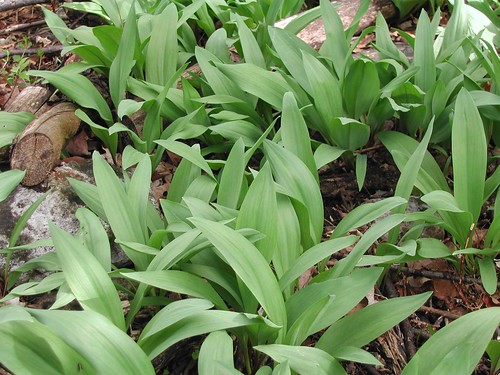
Allium means “garlic” in Latin and tricoccum means “three seeded” which makes sense as seen in this picture.  But in terms of being a spring wildflower the fame of Wild Leek is really based on infamy.
But in terms of being a spring wildflower the fame of Wild Leek is really based on infamy.
As Manon pointed out the leaves poke up above the leaf litter strong and early and are easy to recognize.
People like to eat them.
But too much harvesting over the years has made them an endangered plant and in Quebec it is illegal to harvest more than 200 grams per person per year, or a maximum of fifty plants. Within the Park it is illegal to harvest any at all.
I had noticed signs in Gatineau Park reminding people that they are not supposed to pick the wild leek but Manon said that every year people are arrested and fined for doing just that. She said that enforcement officers have to keep lookout day and night because the leek poachers come in the dark and dig the things up using headlamps and when arrested they often have the trunks of cars packed full of the things.
Part of the challenge is that while the plant is protected this way throughout Quebec, in Ontario it is legal to trade in wild leek so people try to bring their ill-gotten ail across the river, suddenly making it legal. My family privately talked of the practicality of testing for genotypes, assuming that the Quebec leek would have a slightly different DNA than Ontario leeks. In any case there were no flowers to be seen on the leeks when we went although there was no question that the green leaves made a show of themselves, inviting hungry thieves in the night.
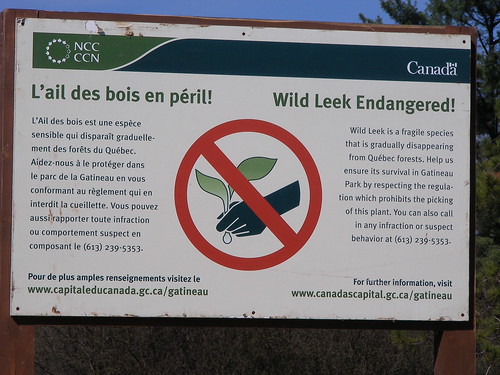
One plant that was flowering was bloodroot which has delicate white flowers that will be gone in just a few days. It’s called bloodroot not because it is poisonous (which it is) but because it oozes a red sap from its roots.
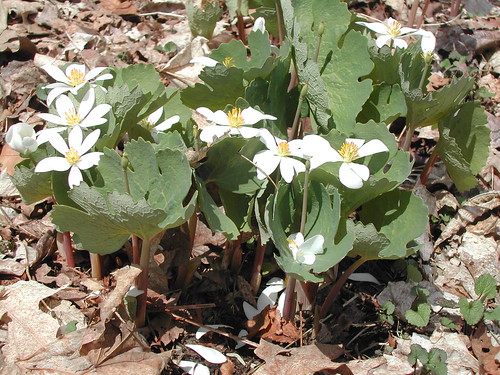
As we walked around the Sugarbush trail we saw the numbers of flowering plants increasing. This was due partially to the increasing warmth of the day as the hour passed, but more because the trail ends up with a south west exposure which gives the plants on that side more warmth and an even greater jump on spring.
Another flower that wasn’t was something called Blue Cohosh.

Later in the season it has boring green flowers but what makes it interesting now is that it comes up out of the ground early and it has a distinctly purple colour; hence its name blue (there’s no accounting for colour perception).
My Oxford English Dictionary tells me that cohosh is “Indian” word – by which is meant a word of one of the amorphous mix of native North American peoples as indistinctly perceived by some anonymous English author circa 1866. Further the OED tells me that the eventual berries that these unformed flowers will produce are also blue and that those same unidentified Indians considered these berries to be medicinal; once again for some ailment unknown.
Wikipedia is far more illuminating saying that Blue Cohosh can induce labor, regulate or suppress menstruation ease childbirth pain as well as being useful as a contraceptive in causing pregnancy to be aborted. I will heed Wikipedia’s sage advice then that “this herb should not be taken during pregnancy.” (Actually I’ll never take it, it sounds dangerous, no matter I’m unlikely to ever be pregnant.)
I seem to be on a bit of a jag here, talking about plants that did not have flowers that we saw on our spring wildflower walk, but somehow they keep on being interesting. There was the Red Berried Elder of which Manon commented that it always looks broken and half dead.
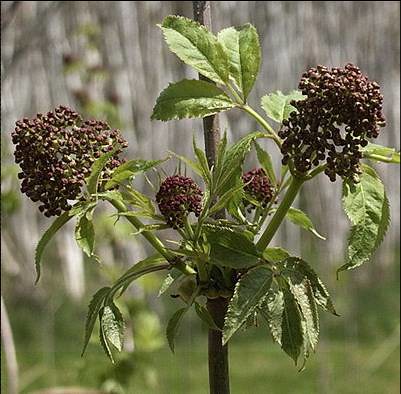
New green shoots were sprouting out ahead of most other trees and shrubs but it was a long way from producing its flowers that will eventually result in those red berries. Its Latin name is Sambucus racemosa and this is a rare case in which the Latin name actually predated the common name. Racemosa just means it produces berries in clusters, racemus being what the Romans called a bunch of grapes. But if you ever wondered how all the plants and animals in the world got given Latin names, and thought that perhaps it was the Romans—the original Latin speakers—who gave them those names, I’ve got news for you. The father of modern taxonomy was the Swedish Carl Linnaeus who started all that Latin naming around 250 years ago. Yet elder as a name for a tree or shrub shows up 1300 years ago in Old English. The only records of Old English words we have that go back that far are little notes in the margins of Latin religious texts that have been kept safe in churches all these centuries. The reason the Old English equivalent of elder was scribbled in the margin was that it was intended to help the priests who didn’t read Latin so good to understand what the word Sambucus meant.
As to flowers that were actually in bloom we saw Dutchman’s Breeches which are sweet little white flowers shaped vaguely like an inverted pair of trousers, slightly short and baggy. That same 1866 book that identified cohosh as an Indian word represents the first time we know of that this name of this flower was set to paper. The poor Dutch have been mocked in English for centuries—Dutch courage being liquor and a Dutch bargain being a contract signed while drunk, there are more—and this same mild insult was likely being applied in the naming of this flower. Who else would wear such funny looking breeches?
Also in flower we saw Broad Leafed Spring Beauty which is a microdot of a beauty.
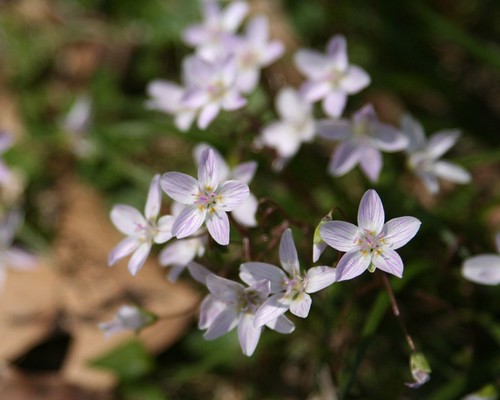
Perhaps we didn’t see narrow leaved spring beauty due to the limits of human visual perception.
We also saw Noble Liverleaf which comes in both white and the prettiest of blues.
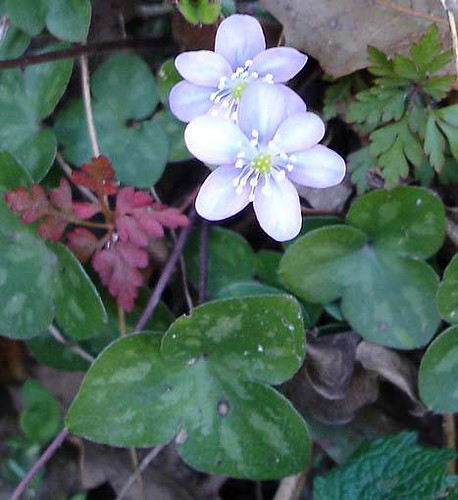
There was talk on the trail of why plants had names like liverleaf and Manon said it was often because people looked at the shape of the leaves and thought they resembled parts of the body and by some magical association must therefore be medicinally applicable to resolving human ailments. My OED backs Manon up on this saying liverleaf as a word is comparable to liverwort, of which it says “applied to various plants having liver-shaped parts or used as remedies for diseases of the liver.”
Manon said that the leaves of the Noble Liverleaf we saw were from last year, the flowers alone being new. New green leaves would grow later, the old ones being a kind of copper brown colour. Since the leaf shape is not particularly liverlike to my eye, nor did “Indians” use the word liver to refer to their own livers, I wondered if it was this liver colour that might relate to the name.
Coltsfoot appear like bright yellow dandelions and are definitely named for their leaves.
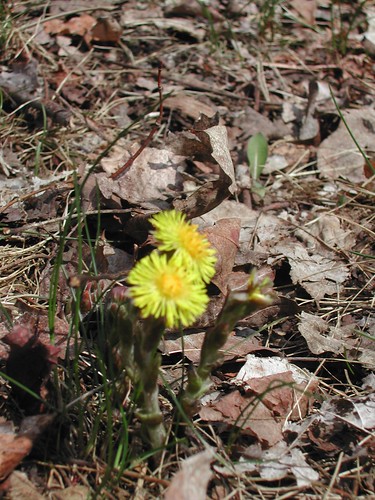
They were bursting out all over. They like best places where the soil has been disturbed.
There were two types of trillium; white and red (the red being purple, again unaccountable colour perception.)
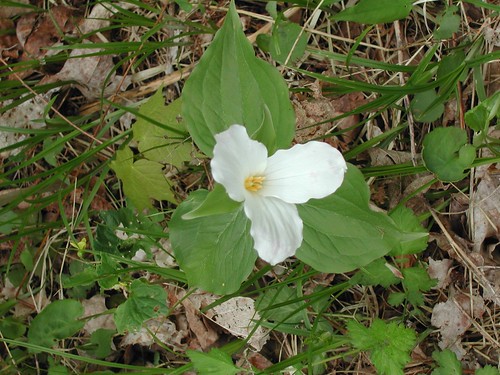
The white stands proud and perky, the red droops sulkily, and well it should because as was explained the thing’s perfume stinks.
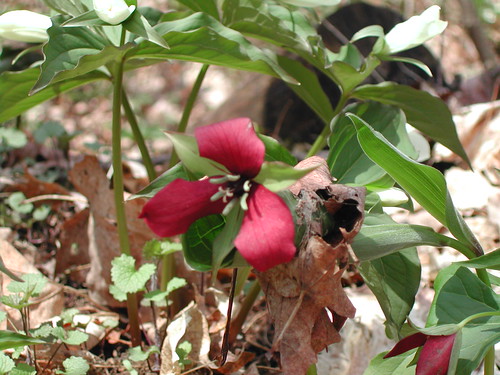
Its ancestors had shamefully opted to use carrion flies as partners in pollination and so has a smell like rotting flesh. No wonder Ontario’s provincial flower is the white trillium.
Trout Lilies are also hard at it cross-pollinating.
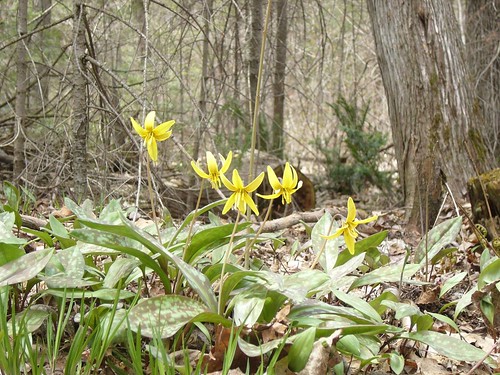
These easily recognizable guys are also sometimes called dogtooth violets, and yellow adder’s tongue. Their Latin name Erythronium americanum has little to do with their looks because Erythronium was the name given by a 2000 year old Greek to some red flowering orchids. But flowing the trail of names is still interesting because at old plant was also known as satyrion after a satyr, those little mythical cloven hoofed people who tempt us to fun, and this was because the plant was reputed to be an aphrodisiac. Oh, and it goes further orchids are called orchids because the shapes of their bulbs reminded people of something else; orchis was Ancient Greek for “testicle.”
Wild Ginger also sprouted along our root and it too has a degree of protection in Quebec as an endangered plant.
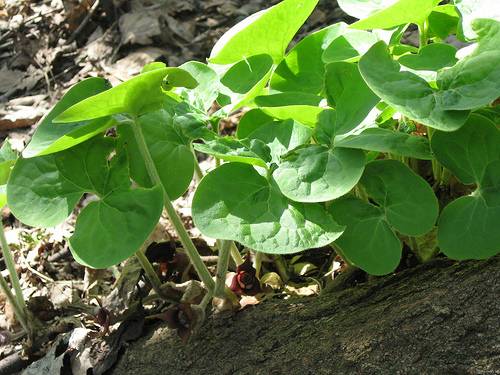
Perhaps less ashamed than the red trillium, the wild ginger does hide its flower under the leaf litter because it isn’t really interested in attracting the bees to pollinate. Instead it hopes that passing ants and other walking bugs will climb inside and help out with the transfer of fertilizing pollen.
We also passed a lovely area of petite blue flowers that Manon observed with a furrowed brow.
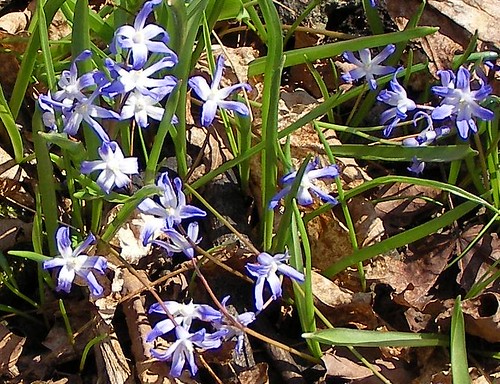
They were nestled among a surrounding patch of Wild Leek and she said that these things, though pretty, were an invasive species. It certainly did appear that they were occupying space that the Wild Leek might otherwise have grown. I don’t know what this little interloper is called so if any of you fans of flora out there do know, comment below or email me and I’ll add that info here.
There are 3 more of these flower viewing weekends scheduled April 18th, 25th and May 2nd.
April 16th, 2010 - 19:17
Scilla Siberica from Siberia.
Also known as Siberian squill, wood squill or spring beauty. A bulbous perennial native to Siberi , it flowers in early spring. Most specimens have blue flowers, but the variety alba is white.
They pop out in early spring, spreading into lakes of blue flowers across suburban lawns. In Ottawa, they grow along Stadaconna Hall, once the house of Sir John A. … where I first saw them in the spring of ‘82.
Named after a horrible sea monster from Greek mythology said to have six long necks topped by grisly heads each sporting three rows of fangs.
“And in the shadow of the sun the snow is blue,
So blue-aloof with a hint of the frozen bells of the Scylla flowe.r”
An invasive species, and among those the NCC wants to eradicate from Gatineau Park.
April 17th, 2010 - 08:36
I meant Strathcona Hall…